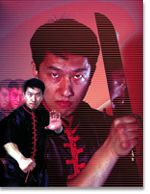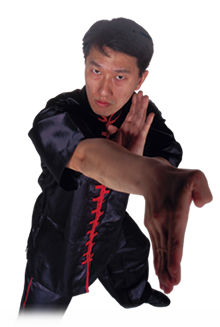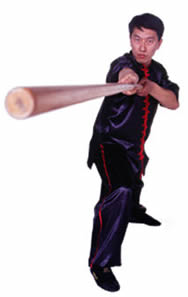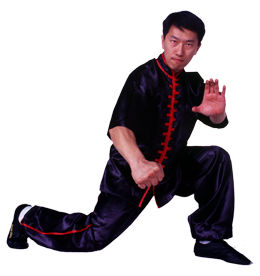Will the Real Wing Chun Please Step Forward!
By Richard J. Loewenhagen (Ving Yat)

Benny Meng Takes Up the Challenge
Stemming from 330 years of revolutionary activity which gave rise to 8 or more major lineages of practitioners across the seven continents, the true roots of Wing Chun Kung Fu (wihng che?n g?ng fuh) defied detection. To the majority of the world's Wing Chun practitioners, those roots were destined to remain shrouded in secrecy and legend. Yet, as often happens in the history of science and man, a small but determined group of men and women went beyond legends and myths.
Sparked by the dreams of a visionary senior teacher of the Yip Man (yihp mahn) lineage and the passionate leadership of a younger one, a handful of practitioners began a revolutionary journey in 1993 to rediscover the roots of Wing Chun. Undaunted, the group logged over 2 million travel miles on 75 major research and support generation trips. Along the way, 17 major magazine articles, a published book and 4 others in the works, 60 seminars, 20 tournaments, and 15 major demonstrations were undertaken to elicit support and open the doors (or sometimes small windows) of knowledge tightly held in both veiled and not-so-veiled organizations.
At every stop on the journey, fierce loyalty to legends had to be honored and sometimes combated. Secrets both political and criminal had to be guarded. Yet science begets science, and the process of documenting history is no less a science than Wing Chun itself. Dedicated practitioners of Wing Chun could and did respond to legitimate investigation, ultimately unfolding into the rediscovery of Wing Chun's rich history and origins.
The Leader
 The leader chosen by fate for this historic journey of discovery was Sifu Benny Meng (s? fuh maahng hing f?ng), renowned curator of the Ving Tsun Museum (wihng che?n miuh s? ?m). Since childhood, he was groomed for a quest such as this. No stranger to travel in pursuit of martial arts excellence, his personal journey began at the young age of 10 in Hong Kong where he studied judo. In 1974 he began studies of tae kwon do in the United States which led to a highly successful tournament career and ultimately a 5th degree black belt in that art. In 1981 he embarked on an extended study of Chinese martial arts that took him back to Hong Kong and Mainland China where he was one of the first Americans to visit the Shaolin Temple and train at the Sichuan Sports University.
The leader chosen by fate for this historic journey of discovery was Sifu Benny Meng (s? fuh maahng hing f?ng), renowned curator of the Ving Tsun Museum (wihng che?n miuh s? ?m). Since childhood, he was groomed for a quest such as this. No stranger to travel in pursuit of martial arts excellence, his personal journey began at the young age of 10 in Hong Kong where he studied judo. In 1974 he began studies of tae kwon do in the United States which led to a highly successful tournament career and ultimately a 5th degree black belt in that art. In 1981 he embarked on an extended study of Chinese martial arts that took him back to Hong Kong and Mainland China where he was one of the first Americans to visit the Shaolin Temple and train at the Sichuan Sports University.
Not knowing that Wing Chun would become his chosen martial art in the future, fate led Meng in 1982 to Sifu Lee Hoi Sang (l?ih h?i s?ng), himself a student of Jiu Wan (j?u w?hn). Jiu Wan was trained by Yip Man in Hong Kong. In his early years as a teacher, Yip Man primarily taught only accomplished artists or teachers of other arts. Jiu Wan was such an individual. He had completed training in the Wing Chun system through Chan Yiu Min (ch?hn y?h m?hn) in Mainland China prior to beginning his training with Yip Man. Chan Yiu Min was the son of Chan Wah Shun (chahn w?h seuhn), also Yip Man's own teacher.
Sifu Meng's training under Lee Hoi Sang was interrupted by his return to the United States. He resumed Wing Chun training under Sifu Moy Yat (m?ih yaht) in New York City in 1985. Studying and training full time, he completed his first trip through the entire system that same year. Sifu Meng officially started teaching Wing Chun Kung Fu in 1987.
In 1994, Benny Meng began another journey through the system with Moy Yat, this time in private lessons. The goal of both the teacher and the student was to examine the details and the deeper aspects of the art form in totality. These intense private lessons were completed in 1995 and he was awarded the Moy Yat family's highest level of technical recognition - a level granted by Moy Yat to only 10 people in his 40 year teaching career.
Due to Grand Master Moy Yat's foresight and wisdom, he instructed Benny Meng to spend time with Moy Yat's own kungfu brothers, thereby showing respect for their accumulated knowledge as well. Sifu Meng began a third journey through the system that same year via extensive private lessons with his S? Baak (kungfu uncle) Yip Ching (yihp jing). This course of study was completed in 1997. He also trained with several other of Moy Yat's kungfu brothers and was certified as a senior instructor by Yip Man's Ving Tsun Athletic Association in China. Fortified with the most comprehensive knowledge possible of the most practiced lineage of Wing Chun, the Yip Man system, he was fate's most logical choice to open the doors of the Ving Tsun Museum to the study and examination of the other lineages of Wing Chun Kung Fu. Numerous Hall of Fame awards, including the USA Wushu Kungfu Federation's formal recognition of his efforts to collate the knowledge of Wing Chun, attest to the magnitude of this quest for knowledge and preservation of a world treasure.
The Quest
The quest for the truth about Wing Chun's roots began in 1993 when Sifu Moy Yat expressed the idea of a Ving Tsun Museum. He emphasized that such an undertaking could not be focused on any one person or lineage - it had to be about the art itself. The problems confronting such a venture appeared insurmountable. Nevertheless, his dedication to academic excellence and a typically Chan (Zen) approach to tackling tough problems triggered the beginning efforts. Meng's extensive private studies into systems thinking and design in the teaching of Wing Chun Kung Fu prepared him well for leading the Wing Chun world on such a journey. Meng could not resist the challenge and immediately took up the quest.
He quickly recognized that the biggest obstacles to overcome would be political in nature. Simply put, many Wing Chun organizations didn't want Wing Chun's roots examined for fear that the results of such a search might lessen the importance of their respective money-making machines or their previously stated positions. Meng emphasized repeatedly that information would be obtained only if researchers and museum promoters adopted a mental attitude of perpetual learning. Each lineage's contributions to the art needed to be studied and cherished.
At the same time, Meng realized that funding would be a major obstacle. Ferreting out truth would not come cheaply. He made a conscious decision to mortgage his businesses, his home and his life for years to come in an effort to generate the funds needed to keep the quest alive and make the dream of a museum come true. The prevailing attitude had to be one of selflessness, devoid of ego. Consequently, the museum was structured as a non-profit organization and privately funded by Meng and his disciples to pave the way for the journey.
With this mindset, Meng and his disciples undertook more than 140 major investigative and promotional events spanning 8 years of research to build the Ving Tsun Museum and dig out the roots of Wing Chun Kung Fu. Benny Meng set for himself the Herculean task of literally meeting and learning from the political leaders as well as the most renowned teachers of every major lineage of Wing Chun Kung Fu. No less than six worldwide trips were required to accomplish such a feat. No other student of the art has ever personally met and examined the knowledge base of so many teachers touching every facet of the art's history and science. More than 20 renowned grandmasters from 8 major lineages of Wing Chun were personally visited and given the museum's complete attention for sharing their knowledge. More than a dozen elected to present in-depth workshops and seminars (some even prepared multiple workshops) at the museum to further this quest for truth.
The Prize
This quest for truth resulted in strong evidence that Wing Chun began in the Southern Shaolin Temple (n?ahm s?u l?hm jih) in the latter half of the 17th century. At this point in history, the Southern Shaolin Temple in Fukien Province (f?k gin) was a hot bed for martial arts training. Several other popular combat systems trace their roots to this same province during the same period in history. This include Southern Mantis (jy? g? t?hng l?hng), White Eyebrow (baahk m?ih), Dragon Fist (l?hng ky?hn), and Fukien White Crane (f?k gin baahk hohk).

Ving Tsun Museum research to-date supports a hypothesis that Wing Chun history unfolded in three principle stages: Concept Design / Field Testing, Modification / Public Awareness, and Commercialization. The ultimate prize from the quest was a realization that Wing Chun's rich treasure of combat training science and applications was not diminished by the centuries. The pieces of the art are still intact and available for continued use and growth in the 21st century.
Shaolin Warriors and the Ming Dyasty
The Concept Design and Field Testing stage began at the Southern Shaolin Temple in 1670's A.D. during a time of war and revolution in Southern China. Highly trained tacticians and teachers needed a single system that could be called upon to address the numerous threats of the myriad of fighting styles employed throughout China. A cutting-edge combat system was needed. The challenge to create such a system was picked up by the warrior monks of the Southern Temple and fugitive General Officers of the remnant Ming Dynasty (m?hng ch?uh) army. The Wing Chun Tong (w?hng che?n t?hng) in the Southern Shaolin Temple was dedicated to these goals. The characters used in the name of this hall translate directly to "Everlasting Spring," the original name given the system. The name itself represents the essence of Shaolin Chan (Zen) kungfu. It represented a secret code used by the designers calling for the rebirth of the Ming Dynasty.
As with all complex system design efforts in time of war, several models were developed and field-tested. The earliest design efforts were heavily influenced by the monk's Chan (Zen) Buddhist beliefs. Chi Sim Weng Chun (ji sihn w?hng che?n) (modern day name meaning 'Extreme Compassion'), as one of the arts, points to the earliest phase in Wing Chun history. It is a complete system of combat training and one of the original expressions of Wing Chun Kung Fu. Its primary purpose was to retain an identity that presented the treasures of Shaolin kungfu - health, fighting skills, and Chan (Zen). At this early stage of development, Wing Chun contained the tools needed to engage in all ranges of combat, from close-quarter to long range with weapons as its foundation. Today's descendants call themselves Chi Sim Weng Chun practitioners and, like their Hung Fa Yi Wing Chun (h?hng f? yih wihng che?n) counterparts discussed below, trace their roots directly to the Wing Chun Tong in the Southern Shaolin Temple. A modern day representative of this system, Sifu Andreas Hoffmann, resides and promotes this lineage in Germany.
Paradigm Shift
Along with the already combat effective Chi Sim Weng Chun, Hung Fa Yi Wing Chun was developed along a true paradigm shift in hand-to-hand combat thinking. Prior to this point in time, styles of combat were based on art and self-expression. Hung Fa Yi was created in an environment based strictly on human physiology and the physics of time and space. Personal artistic expression became irrelevant. Absolute control of time and space, with predictable and repeatable results in combat, represented the center of all focus. Science replaced art in the structure and evaluation of the entire style. At the same time, the military logistic imperative for training warriors in a feasible time-frame became a paramount concern and was given overarching consideration.
The ten years intensive training required to master classical Shaolin postures was not logistically viable. This version of Wing Chun may have been created by a different group within the same Wing Chun Tong or the same group heavily influenced by military thinking from Ming Dynasty officers; either way, members of the Chu royal family, the former leaders of the Ming Dynasty, supported this group. This is the first time in the development of Shaolin fighting systems that time and space themselves became the focal point of design consideration. They provided the "idea" in the first level of Siu Nim Tao (Little Beginning Idea) training. The military implications of this decision are far too extensive for review here. Suffice it to say the physical science expertise of the monks, resulting from their relentless pursuit of the laws of nature and universal harmony, paired with the tactical and logistical training necessities confronting the professional soldiers, yielded the ultimate fighting system in terms of efficiency and effectiveness.
Both Chi Sim and Hung Fa Yi lineages focus on the strong Chan (Zen) Buddhist view of existence in terms of time, space, and energy. This same focus remains at their cores in the 21st century. However, in Hung Fa Yi the major components of the Wing Chun fighting system's modern day identity take on its key structures and form. This is where the Siu Nim Tao (little idea in the beginning), Chum Kiuh (sinking bridge), and Biu Ji (thrusting finger) forms of Wing Chun Kung Fu were first seen. Chi Sim does not reflect these forms and employs traditional Shaolin structures.

The inheritor of the Hung Fa Yi system, Sifu Garret Gee (jy? g?ng h?hng), lives and promotes this lineage in San Francisco, California. The name "Hung Fa Yi" literally translates to "Red Flower Righteousness' with its origins in the secret societies surrounding the Southern Temple during this period of continuous resistance fighting with the Manchu armies. The phrase "Hung Fa" came from Hung Fa Wui (h?hng f? w?ih), a Shaolin secret society counterpart to the Hung Muhn (h?hng m?hn) revolutionary society. The word "Righteousness" emphasizes practitioners' strict adherence to the highest moral standards in conduct and battle in the fight for their country's honor and preservation of their Han heritage. By this time the characters used to depict "Wing Chun" have changed to mean "Praising Spring." The secret code had by this time evolved to encourage practitioners to continue talking about and soliciting support for the rebirth of the Ming Dynasty.
Revolutionaries and Secret Societies
Hung Fa Yi became the primary combat system of the secret societies. Revolutionary leader, Jeung Ngh (j?ung ?gh) (often written as Cheung Ng), the temple inheritor of the Hung Fa Yi Wing Chun, made the art available to revolutionaries through a cover organization called the Excellent Flower Association (k?hng f? w?ih g?n) in public (also called Red Flower Association by the secret societies). The Excellent Flower Association (often called the "Red Opera") formed around 1720 AD and was an ideal cover for training and distributing a fighting system because its public nature was the performance of Chinese Opera. Performers could travel extensively with legitimate cover and disguise. Combat training took place in the dark of night and public performances could be scheduled for regions where training was most needed.
For the next century, both Chi Sim and Hung Fa Yi Wing Chun fighters were trained and employed secretly to support continued revolutionary efforts. By the mid-19th century, the fervor for return of the Ming family to the throne had dissipated. The Qing Dynasty (ch?ng ch?uh) was firmly established and public dissent was focused more on political corruption and fighting the Western Imperial expansion. The largest revolution occurred in 1844 - 1850. The Qing successfully suppressed it and the Red Opera, along with many other Opera societies supporting the revolution, was destroyed during the Qing victory. This opened the doors for opera refugees to begin disseminating the art in modified versions and variations to the general public.

Wing Chun Flourishes
The second phase of Wing Chun development, Modification and Public Awareness, arose and flourished over the next 100 years. During this era, Wing Chun went through its third period of major change in form, footwork, and structure. Environmental and cultural factors such as exposure to life on boats in the southern coastal regions of China for over 100 years may have heavily influenced stances and training methodologies. The art began a transition from military employment to civilian use and support. As a result of this transition, Wing Chun outside the Hung Fa Yi tradition began to discard its scientific orientation and revert back to a focus based on individual expressions and personal experience. Likewise, students were no longer required to endure hours of initiation ceremonies and blood oaths to fight to the death for a specific cause. Nevertheless, Wing Chun's fighting effectiveness continued, as repeatedly demonstrated in challenge matches with other styles and individual opponents. The majority of today's most popular lineages stem from roots in this era. Two of those lineages stem from one man alone for each: Yip Man and Gu Lao (g? l?uh). Both originated from Dr. Leung Jan (l?uhng jaan), who learned his Wing Chun directly from Red Opera members. Others lineages include Pao Fa Lien (p?auh f? l?hn), Yuen Kay San (y?n k?ih-s?an), Pan Nam (p?ahng n?ahm), Nanyang (n?ahm y?uhng), Cho family (ch?uh ga), and numerous subsystems practiced throughout Southeast Asia.
The legends of Wing Chun's roots also flourished during this period. The famous story of a young woman trained by a Buddhist nun creating and disseminating the art through the Red Boat Opera became quite popular. Ex-revolutionaries distancing themselves from the secret societies and governmental persecution most likely promoted the popularity of this legend. Many popular Chinese fictional books and magazines were written and published at the turn of the century. Many fables about martial arts orientation resulted from the stories in these works, including the legend of Yim Wing Chun (y?hm wihng che?n). It is important for all students of history to note that these were purely fictional works, not historical treatises. Nevertheless, they still fueled legends.

The Commercialization Phase of Wing Chun represents its rapid expansion in modern day. This stage emerges in the mid-20th century with the flight of Wing Chun teachers from Mainland China resulting from political instability during China's civil war. Its popularity quickly spread across the globe, due primarily to the renowned fighting success of Yip Man's gong sau (talking hands) fighters and the movie-making success of Bruce Lee (l?ih s?u l?hng). Today, the Ving Tsun Athletic Association (wihng che?n t?i yuhk w?ih) in Hong Kong serves as a nexus for the Yip Man lineage. Along with rapid growth came the politicization of the art in the form of arguments over "who" inherited the real Wing Chun and the resultant rights to control its commercialization through franchises, certifying associations, publications, videos, internet entities, etc.
Wing Chun's True Prize
The real prize of this journey was the realization that Wing Chun has not yet been lost to commercialization. Practitioners can still find all the pieces of the art and its history spread across all three stages of historical evolution. Collectively, they represent Wing Chun. Practitioners need to begin the return to a harmony reminiscent of the one emphasized by its original creators - the Shaolin monks. The system itself should enable its practitioners to seek and achieve that harmony in an atmosphere free from the corrupting effects of politicization. If the focus becomes perfection of learning and practicing the complete art, Wing Chun's survival can be assured. The countless efforts of Sifu Benny Meng and his museum staff throughout their incredible journey reflect a beginning move in that direction of harmony for all of us. A message ushers forth here for martial art traditionalists of other styles as well. The pieces of the myriad styles of Chinese kungfu are alive and intact. If traditionalists are willing to take on journeys such as this one, they too can trace the true roots of their arts and lay myths to rest.
Sifu Meng attributes the museum's success throughout this journey to his insistence on maintaining a continuous desire to learn and an open attitude that permitted it. He emphasizes four key elements that turned an impossible quest into successful reality. The first is the Chan (Zen) approach to Wing Chun instilled in him by Sifu Moy Yat. The second was the tireless and unselfish efforts of his Wing Chun disciples and the museum's operations manager, Sunmi Meng. The third key element to success was the sincere cooperation of many Wing Chun masters spread across every major lineage of the art, especially Yip Ching of the Yip Man system and Andreas Hoffman of the Chi Sim system. The final element to success was born out of the courageous trust and confidence placed in Benny Meng by the inheritor of Hung Fa Yi Wing Chun System, Sifu Garret Gee through the detailed, scientific knowledge he strove to share. Benny Meng became one of the first insiders of this rare, scientific system.
The trail for the journey is now forged. Doors are open for Wing Chun practitioners to undergo similar sojourns of learning. As has happened throughout history, others will follow that same trail and it will widen into a road and eventually become a super highway. In the words of trailblazer Benny Meng, "On with the Quest!"
Click here for Feature Articles from this issue and others published in
2001 .
About
Richard J. Loewenhagen (Ving Yat) :
Sifu Richard Loewenhagen is a full time teacher and director of Wing Chun Kung Fu at Meng's Martial Arts of Arizona. He is the first disciple of Sifu Benny Meng to complete discipleship training in the Yip Man system of Wing Chun and is currently engaged in a discipleship training program of Hung Fa Yi Wing Chun. Sifu Loewenhagen was the Vice Chairman of the Ving Tsun Museum Founding Committee and today serves as the Museum's West Coast Director. He is also the co-author of the most comprehensive Wing Chun history book (soon to be published) ever undertaken. He can be reached at: Meng's Martial Arts of Arizona, 3029 N. Alma School Rd, Ste 218, Chandler, AZ 85224, (480) 820-2428, email: sifu@mengsofaz.com. The Ving Tsun Museum can be contacted at: Ving Tsun Museum, 5715 Brandt Pike, Dayton, OH 45424, (937) 236-6485, email: host@vtmuseum.org
![]() Print Friendly Version of This Article
Print Friendly Version of This Article
















